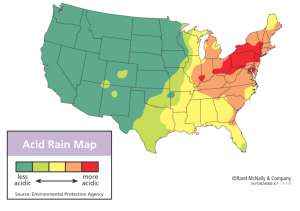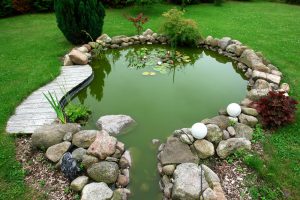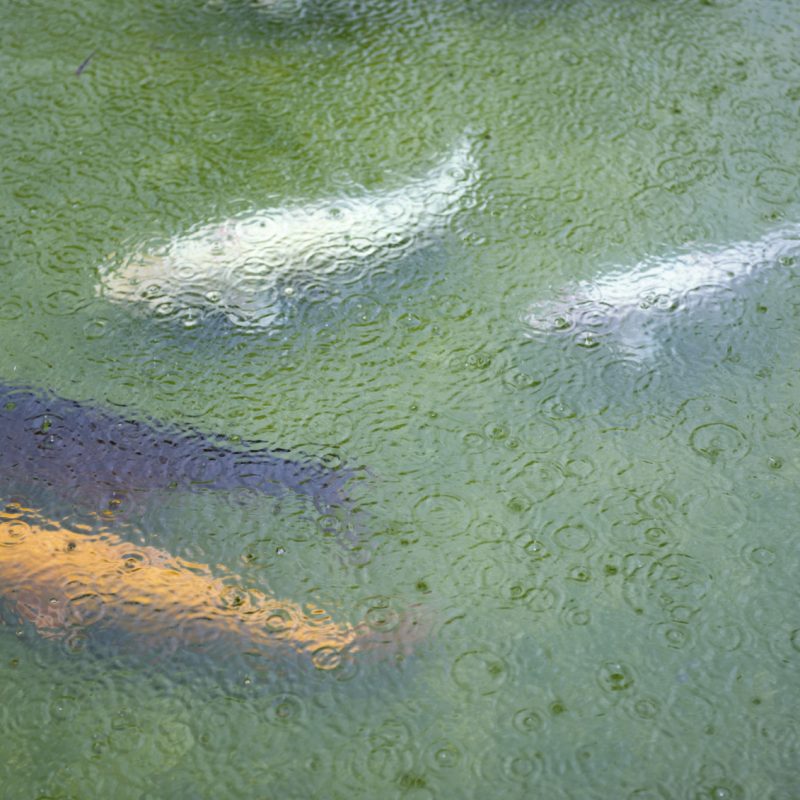In some parts of the country, it has been a wet and rainy Spring. Any water that is entering the pond from an uncontrolled source is usually an uncontrollable source of concern.
A koi keeper’s primary concern is always the water parameters and the effect that any rain might have on the water quality.
So you will more than likely have questions regarding how rainwater affects the condition of your pond water quality and parameters.
Is It Bad For My Pond?
Rainwater can be a free source of unchlorinated, softer water, that your local utilities department will not be able to bill you for, but it can carry pollutants and chemicals into your pond, too.
It really depends on where you are. Farms (using pesticides and fertilizers), cities (from emissions and other urban pollutants) and heavy industrial areas all have above average chemical outputs that will influence the type of rain that falls. Rainwater (and runoff) can have a range of substances—pesticides, heavy metals, inorganic ions (like sulfate and nitrate)—that can affect a pond negatively.

Is Acid Rain Something to be Concerned About?
It isn’t acid that falls from the sky, but there are conditions (some natural and some man made) that will affect the overall pH of rainwater, making it more acidic. Some regions in the country (like the Northeast) are more affected by acid rain than others.
This site looks at the distribution of acid rain in the US and can be helpful in determining whether your pond water might be affected when experiencing high rainfalls.
Does the Size of My Pond Make a Difference?
By and large, yes. Smaller ponds in a bigger rain will see the effects more clearly as the overall composition of the rain will more quickly dissolve into a smaller volume of water. But again, don’t panic. Keep your eye on the pH of the pond after a big rain and do your water changes accordingly.
Should I Be Worried That My Water is Cloudy?
This is ordinarily a result of whatever soil is being washed into your pond or it can be sand particles, dust, pollen, dirt and/or flotsam and jetsam debris.
In some cases it’s simply your filtered water mixing with the rain water. It usually settles after a few days.
If your pond is on a downgrade, however, it might be runoff, which can have harmful chemicals from lawn care (like fertilizers or pesticides). If the cloudiness persists check your parameters frequently and perform water changes as necessary.
What is pH?
Short for potential of hydrogen, essentially it is the number of hydrogen (H+) and hydroxyl (OH-) ions in a given sample of water.
More hydrogen means the water will be more acidic while more hydroxyl means it is more basic. pH is a scale that ranges from 0 to 14. Anything lower than 7 being acidic and above 7 being alkaline (basic). Between 7.0 and 8.6 is the ideal pH reading for healthy and happy koi.
Pond water is hardly ever completely neutral in its balance. You will find that your water’s pH can vary at different times of the day, too.
There is always the concern that rainwater will introduce harder chemicals (like aluminum) as well as negatively affect the overall pH. That is why it is important to keep it within a range.
What is a pH Crash?
A crash is when your water’s pH parameter moves from a neutral balance between alkalinity and acidity to being more acidic in a short space of time.
When the pH dips below into the sixes or worse, it is known as a pH crash and can be lethal.
Why Should I Be Worried About a pH Crash?
Your koi have biological mechanisms to deal with small shifts in pH in their environment. By releasing stored acids or bases into their bloodstream, your koi can help to account for the change in its environment.
These large swings in pH in a short space of time, however, don’t give koi sufficient time to make the change, and can lead to Acidosis or Alkalosis. When pH is below 6.5, growth will be stunted and in the 5.0 range your koi will start to die off.
Issues that Rain Raises
Some things to watch for after a rain.
Debris
No one needs to tell a koi enthusiast that cleanliness is next to Godliness. Clear any foreign matter that the rain or storm has carried into your pond. You don’t need any more organic material in your pond than your koi already create. Also, you want to keep the surface clear to allow sunlight in.
Runoff
Weed killer, fertilizer, bricks and freshly laid new cement all have chemicals in them, that can affect the pH and general condition of your water.
If your pond is at lower grade than the rest of the area that it is housed in, the runoff is what you should be most concerned about—especially if there is poor drainage. The same goes for ponds under the eaves of houses. There can be some fairly toxic stuff on roofs, too.
Algae
 Rainwater and runoff can also introduce nitrates into your pond water. And this is manna for hungry algae. You might find that you get a quick bout of green water after a rain as your pond water starts to filter out the excess nitrates and other nutrients that the rain has brought in.
Rainwater and runoff can also introduce nitrates into your pond water. And this is manna for hungry algae. You might find that you get a quick bout of green water after a rain as your pond water starts to filter out the excess nitrates and other nutrients that the rain has brought in.
How to Combat Rain-based Issues
Buffering
Anything that will counter increased acidity is helpful. Carbonates and bicarbonates are the best solution to raising the pH of pond water. Baking soda (Sodium Bicarbonate) is another old faithful and good in a pinch after a pH crash. However, it is better saved for use in an emergency situation.
Oyster shells are a great and long term solution to regulating pH and are a favorite amongst koi owners. It will eventually degrade as the necessary chemicals are leeched over time.
There are numerous pH buffering options on the market and each has its supporters. It is important to remember that if you are opting for a liquid or powder alternative, make sure to check the pH after every dose and stick to the dissolution protocols laid out on the product you are using.
Be Vigilant
There’s nothing wrong with being a worry wort. A little cortisol in your own endocrine system usually helps to keep your koi’s stress levels down. Just perform all of your usual monitoring protocol and maybe ratchet it up a little after a heavy rain.
Water Change
Routine water changes are a necessity in any pond with many enthusiasts swapping out anywhere from 10-40% of their pond’s total volume at least once a week. This amount and frequency can be changed according to water quality if parameters are out of whack. Keep a close eye on parameters and if the rainfall causes pH swings or raises the nitrate level consider a higher volume replacement.
Swab the Decks
After a big rain, there is usually debris floating on your pond. Make sure that you clear the surface of the pond. You might even want to consider a vacuum to get anything that has made its way to the bottom of your pond. Your koi add enough organic matter of their own to the pond. You don’t need any more in there.
Diverting the Flow
If your pond is under the eaves of your house, make sure that any rainwater is diverted away from the house. There’s no need to add anything that washes off your roofing tiles or shingles. Also, check to see how the space around your pond drains. It is useful in knowing what you are likely up against for any runoff that will occur.
As a koi keeper and outdoor pond enthusiast, knowing and understanding the many factors that might influence a pond’s water parameters can be vital in anticipating changes in the aquatic environment. And this knowledge can be instrumental in identifying and diagnosing potential issues before they arise as well as getting a head start on re-establishing safe limits for you koi.


My Mother has a small 145 gal preformed koi pond within a screened in enclosure that constantly has a film substance floating on top. What is it and how do you get rid of it? We have bought (and taken back) several submersible pumps/filter in the past. (either too strong or) like now -to me not strong enough to keep it clean. What pump/filter etc do you reccomend,
Hi Jolene,
The film you are noticing on the pond surface is something referred to as biofilm. This is usually produced by bacteria in the presence of large amounts of decaying plant or animal life, excess fish waste, and fish food. We do apologize, as we are not pond product experts and are not able to throughly answer your question. We recommend contacting an Aquascape Pond Builder or Certified Aquascape Contractor in your area. They are much more knowledgable with pond builds and maintenance. You can try finding one via the link provided below.
https://www.aquascapeinc.com/find-aquascape-certified-contractors
Thank you.
[…] Rainwater and Your Koi Pond […]
[…] Rainwater and runoff can also introduce nitrates into your pond water. And this is manna for hungry algae. You might find that you get a quick bout of green water after a rain as your pond water starts to filter out the excess nitrates and other nutrients that the rain has brought in. via […]
[…] Rainwater and runoff can also introduce nitrates into your pond water. And this is manna for hungry algae. You might find that you get a quick bout of green water after a rain as your pond water starts to filter out the excess nitrates and other nutrients that the rain has brought in. via […]
We just are having a heavy rain right now and I’m worried about my goldfish and the pond is there anything I can do when the rain stops to save my fish?
Hi Donna, We have a few solutions mentioned in this article. However, you will mostly want to monitor runoff into your pond and test your water parameters to ensure that everything shows acceptable readings for the fish. If parameters are off, you may want to perform a partial water change or add the necessary pond chemicals to balance your readings.